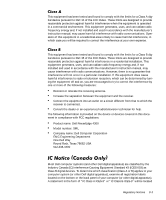Dell PowerEdge 4300 Dell PowerEdge 4300 Systems User's Guide - Page 118
Power Protection Devices.
 |
View all Dell PowerEdge 4300 manuals
Add to My Manuals
Save this manual to your list of manuals |
Page 118 highlights
Each Dell system, when operating, is designed to withstand 0.25 G (half-sine wave) at a sweep of 3 to 200 hertz (Hz) for 15 minutes. In storage, the system can withstand 0.5 G at 3 to 200 Hz for 15 minutes. Systems are especially sensitive to variations in voltage supplied by the AC power source. Over-voltage, undervoltage, and transients (or spikes) can erase data from memory or even cause components to fail. To protect against these types of problems, power cables should always be properly grounded and one or both of the following methods should be used: Use one of the power protection devices described in the following section, "Power Protection Devices." Place the system on a dedicated power circuit (rather than sharing a circuit with other heavy electrical equipment). In general, do not allow the system to share a circuit with any of the following: - Copier machines - Air conditioners - Vacuum cleaners - Space heaters - Power tools - Teletype machines - Adding machines - Laser printers - Facsimile machines - Any other motorized equipment Besides these appliances, the greatest threats to a system's supply of power are surges or blackouts caused by electrical storms. Whenever possible, turn off the system and any peripherals and unplug them from their power sources during thunderstorms. If a blackout occurs-even a temporary one-while the system is turned on, turn off the system immediately and disconnect it from the electrical outlet. Leaving the system on may cause problems when the power is restored; all other appliances left on in the area can create large voltage spikes that can damage the system. A number of devices are available that protect against power problems such as power surges, transients, and power failures. The following subsections describe some of these devices. C-8 Dell PowerEdge 4300 Systems User's Guide















